Review: Cheesy khachapuri and Georgian soup dumplings await at Glendale’s Havlabar
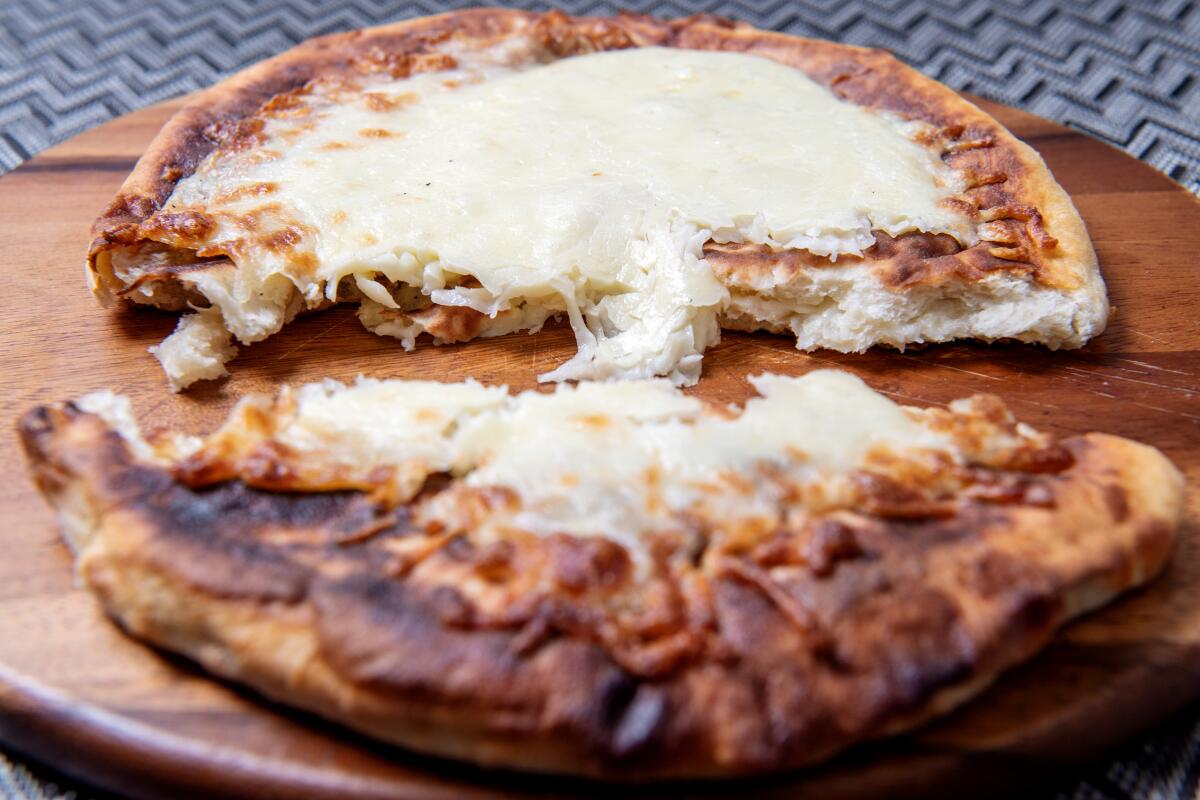
- Share via
The unknown tugs at the human psyche. Havlabar, in a Glendale strip mall between a doughnut shop and a nail salon, has no windows. The space’s previous occupant sold booze and kebabs; its façade was mostly tinted glass. Now it is plastered with red brick siding and decorated with large photographs of pleated dumplings, cheese-slicked bread and chicken drumsticks scattered with pomegranate seeds. A carrot-orange sign reads “Georgian cuisine.” The door is opaque. There is no seeing inside.
I first noticed Havlabar, which opened in May, a couple of months back while swinging by Lahmajune Factory, a Lebanese Armenian bakery in the same complex. Curious, I ditched my lunch date with a za’atar and cheese man’oushe and stepped inside.
My eyes adjusted from a cloudless California afternoon to what felt like a hotel banquet room cut off from space and time, eternally awaiting guests: formal, arching chairs upholstered in red; napkins fanned out in empty water glasses as part of the preset place settings; squat, rectangular crystal chandeliers spaced across the ceiling. Geometric patterns of overlapping circles and curved triangles swirled across the gray walls like an airline logo missing a company name. Two mounted screens faced each other: One flashed pictures of cheesy bread and meat dishes arranged in shallow clay pots; the other played a video of singer Varduhi Vardanyan’s anthem “Armenia.”
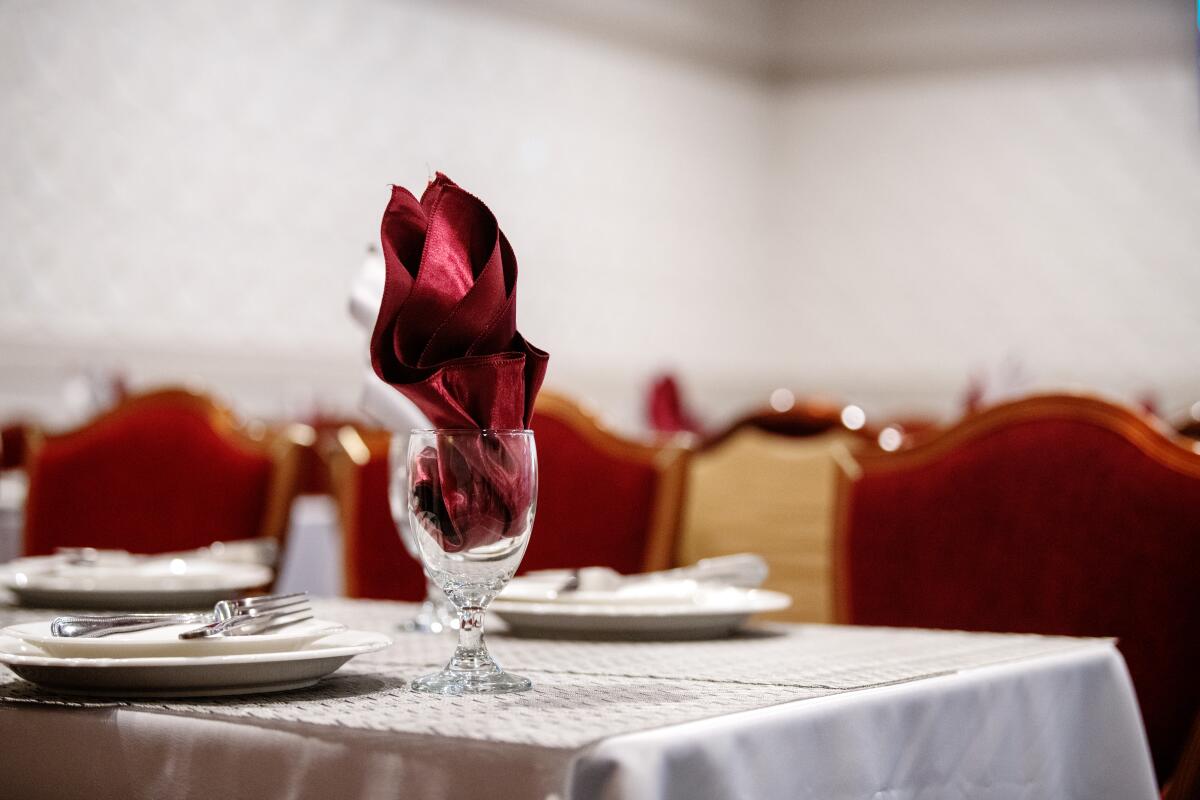
I was the only customer. The server pointed me to a table and said, in English, “I speak Armenian and Russian.” The menu included color images of every item. We pointed and nodded and managed just fine.
Owner Gohar Muradyan is Armenian: Havlabar’s menu is two-thirds Georgian dishes and one-third Armenian specialties, a reflection of the chefs she hired and their respective fortes. The restaurant’s name refers to a district in Tbilisi, the capital of Georgia, where the city’s Armenian population traditionally has resided. Muradyan knows her audience: The restaurant, when busy, tends toward groups that crowd around the large tables. She also grasps the strengths of her kitchen. The glossies hung outside the restaurant depict the best things to order here.
Georgian food stands as a cuisine that some writers (guilty hand raised) like to predict will suddenly take hold in the American mainstream. Maybe someday. The country’s position between the Black and Caspian seas has made it a significant trade route throughout history. Persian, Turkish and Indian influences can be gleaned in its herbed meats paired with sour fruits, the presentation of pickled and fresh vegetables, and the prominence of hot breads. (For an insightful read, Darra Goldstein’s “The Georgian Feast” provides compelling recipes and deep context.)
Khachapuri — the doughy joy that falls somewhere between bread and pastry — is arguably the most famous Georgian dish stateside. The canoe-shaped version from coastal Adjara, filled with cheese, butter and egg yolks in its hollowed center, has achieved Instagram immortality. Havlabar does not serve that one, which nudges diners to try other variations. A riff on Imeruli khachapuri, a classic round pie, is stuffed with mozzarella-like sulgani and baked to a russet brown; it crackles and stretches and oozes radiantly. I prefer it to a close variant in which the cheese melts on top.
The scene-stealer, though, turns out to be sausage-shaped, sulgani-filled khachapuri grilled on skewers; they come as a duo, bronzed and speckled, rolled thin enough that their cylindrical crusts become layered and flaky. Break them in half and the cheese, soft but not entirely molten, pulls in long, fairy-tale strands. They’re not quite as ’Gram-worthy as their Adjaruli counterpart, but they trigger childlike delight.
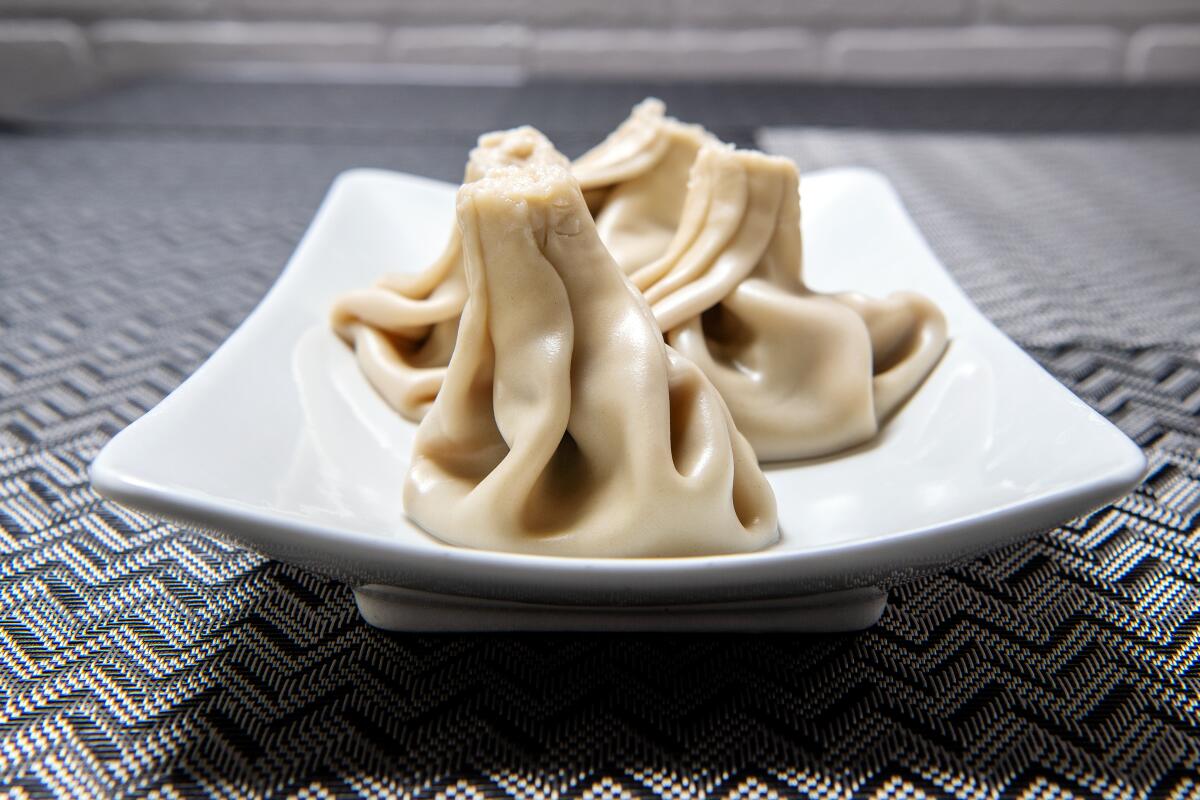
Khinkali, pleated dumplings filled with a spiced mixture of ground pork and beef and meaty broth, are a Georgian classic. The revelers at the big tables ask for platters of boiled khinkali. Watch them and learn: Hold a dumpling in your hand by its twisted topknot and bite off a piece of its round base. Let a little steam escape and then slurp out the soup. Polish off the rest until all that’s left is the knob, which will resemble the papery severed head of a garlic bulb when you’re through. Eat khinkali quickly, before the slippery wrapper, wonderful when hot, cools and seizes into a texture not unlike latex.
Havlabar’s boiled khinkali rival the meaty exemplars at nearby competitor Khinkali House. I’m not as enamored when Havlabar fries its khinkali, which saps the contents of their juiciness and leaves them rather dry.
Two standouts featuring walnuts, which show up meaningfully in savory Georgian cooking, nicely round out a meal of dumplings and cheese bread. A plate of pkhali presents spinach, eggplant and beets each separately pureed and zinged with vinegar and spices like coriander and fenugreek; ground walnuts bind them as they’re shaped into delicate spheres. Sacivi (also spelled satsivi) is built on a smooth herbed walnut sauce in which cooked, bone-in chicken marinates overnight. Garlic slices through the nutty richness; use the restaurant’s crusty bread to scoop up the sauce.
Meat dishes dominate the rest of the menu. Among the Georgian selections, chakapuli, lamb chops simmered in white wine with plenty of tarragon, gets a twangy boost from sour plum sauce. Tomato-laced stews and potato-laden casseroles often contain pork and veal that have been cooked to chewiness. On the Armenian side, I’m particularly keen on dolmas, the grape leaves bundling a fluffy mixture of oniony ground beef and pork gently bulked with flecks of rice.
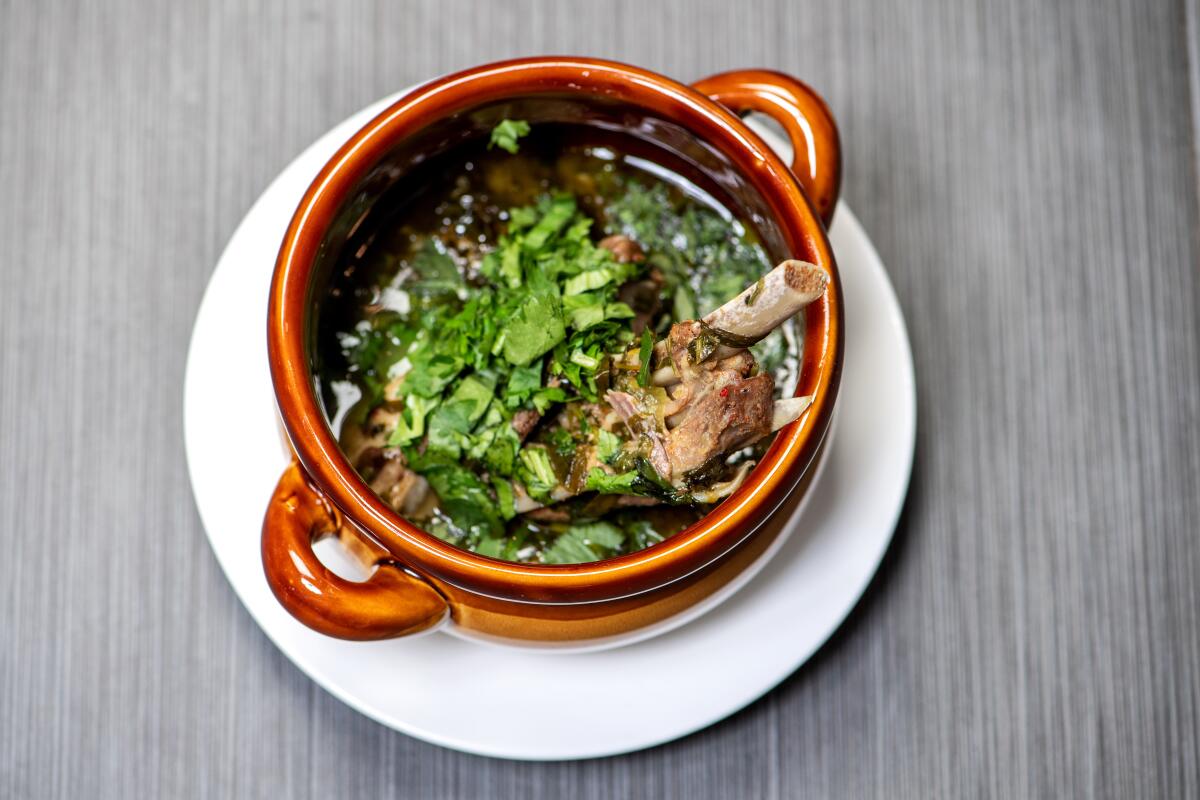
There is no dessert menu; ask for “cake.” If the timing is right, there will be a free-form sort of Napoleon or a spiced layer cake with custardy buttercream. Armenian coffee banishes any thought of a food coma. At another quiet lunchtime, a colleague brought her Armenian friend, who, for fun, read her fortune in the coffee’s grainy slurry. The Armenian server smiled in recognition as she tipped the cup upside down and waited for the grounds to slowly slide down the sides. She saw a tiger in the trails, and three lingering questions, and worries and omens. She looked foreboding for a minute and then laughed. We all did.
I glanced at the door, with its blackout glass, and wondered if anyone could possibly imagine the scene within unless they stepped into Havlabar for themselves.
Havlabar
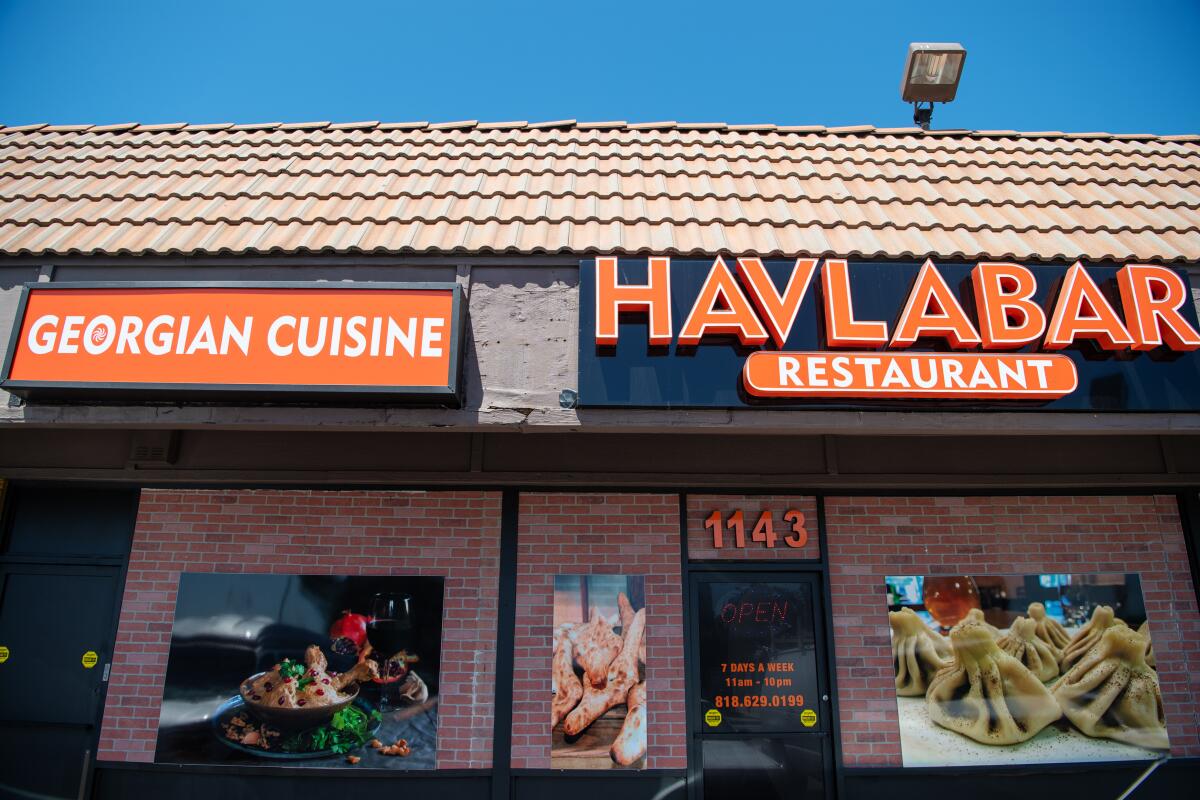
Location: 1143 E. Broadway, Glendale, (818) 629-0199, facebook.com/havlabarrestaurant
Recommended: Khinkali (meaty soup dumplings), grilled khachapuri, sacivi (chilled chicken in walnut sauce).
Prices: Appetizers and salads $10-$16, entrees $10-$22, breads $6-$14.
Details: Credit cards accepted. No alcohol. Street and lot parking. Wheelchair accessible.
More to Read
Eat your way across L.A.
Get our weekly Tasting Notes newsletter for reviews, news and more.
You may occasionally receive promotional content from the Los Angeles Times.










